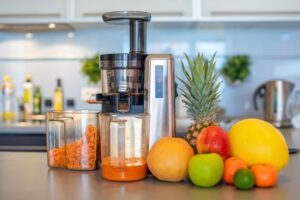
How to Clean a Juicer
Have you ever questioned how to clean a juicer? Well! You aren’t the only one in this shoe. Many people who use juicers often find cleaning the kitchen appliance difficult. It is a common complaint among users.
Whether the centrifugal force or the Cold Press, stuck ingredients may find their way into your new drink. These small bits may be decayed, which can cause bacterial infections. Luckily, juicers are dishwasher-safe and can be readily cleaned with soap. This article will teach you 10 easy ways to keep your juicer clean and healthy.

What You’ll Need to Clean Your Juicer
The following is what you’ll need to clean a juicer;
- A non-abrasive sponge
- A soft toothbrush
- Spatula
- Clean microfiber cloth
- One dishwasher
- One dishwashing liquid
- One baking soda
- Distilled white vinegar
You can clean a juicer in these 10 easy steps:
Cleaning a juicer is simple. All you need is the right tools/ pieces of equipment and materials.
1. Turn Off & Unplug the Appliance
You wouldn’t want to get electrocuted while cleaning your juicer, so turn it off. Unplug it from the wall socket before cleaning.
2. Disassemble the Juicer
Carefully disassemble the juicer components according to the manufacturer’s guide. It involves taking apart the pulp and juice container, filter, feeding chute, cutting blades, and plunger.
3. Empty the Pulp Container
With a spatula, remove any ingredient in the pulp container. If unusable or hardened, throw it into the trashcan. If you plan to use the pulp, use a food-safe bag to contain it.
4. Wash or Rinse Components
If the juicer is dishwasher-safe, toss the removable components in a sink with hot water and add dish soap. Allow the parts to soak for three minutes. Then use a non-abrasive sponge to scrub them thoroughly. Focus on the crevices and corners for buildup. Use a soft brush for the strainer and the grinder.
Rinse the components with hot water and air dry. Also, you can use a microfiber cloth to dry the pieces.
5. Clean the Juicer Base
Moisten the non-abrasive sponge with water to clean the base. Avoid submerging it in water to avoid damaging the motor. Dry with a microfiber towel afterward.
6. Clean the Remaining Parts
Clean the other parts with a microfiber cloth. Ensure they are properly dry before reassembling the juicer to avoid bacteria growth.
7. Wipe the Remaining Components
Wipe down the juicer’s body with a damp cloth to prevent spills. Make sure they are thoroughly cleaned to avoid electrical shock.
8. Dry the Detachable Parts
Air dry the removable parts if they still look damp. You can place them near an air dryer for a quicker result.
9. Reassemble the Juicer
Now that every component is thoroughly cleaned and dry, it’s time to reassemble. If you need help remembering to assemble the parts, go through the manual.
10. Wrapping Up
Cleaning the juicer is easy if you follow the steps meticulously. Abiding by these steps will keep your juicer in excellent condition. In addition, it ensures your juicier continues to make deliciously-made juices. Always remember to consult the user manual for improved use or cleaning.
Why is a Clean Juicer Important for Your Health?
Cleaning a juicer not only maintains the effectiveness of the machine but guarantees healthy juices. It is paramount for your health for the following reasons;
Reduces Bacterial Growth
Regular cleaning can prevent the growth of bacteria like E. coli and Salmonella. Raw fruits and veggies have bacteria, which can multiply if you put them in an unclean juicer. It eventually results in foodborne diseases. Cleaning your juicer can prevent bacterial growth and maintain healthy foods.
Removal of Potentially Harmful Chemicals
Some fruits and veggies are treated with chemicals to prevent insect attacks and boost yield. This is true for the commercially-grown ones. When juicing, these chemicals can linger on the juicer’s surfaces. If the juicer is unclean, the chemicals will mix with the residues and produce dangerous compounds in your drink. That’s why you should clean your juicer after every use – to minimize the risks of exposure.
Nutrient Preservation
Newly-made juices are rich in vitamins that are health boosters. But exposure to light and air can cause a depreciation in nutrients. An unclean juicer contributes to the buildup of residues that can cause nutrient loss. A clean juicer preserves the nutrients.
Prevents Mold Growth
Juicers can be damp, especially if improperly dried after cleaning. Leftover moisture can lead to mold growth, which contaminates fruit juices. A contaminated juice can introduce various sicknesses and diseases to your life. Regular cleaning and proper drying can prevent fungi growth and eventually reduce diseases.
Fresh Flavors
A clean juicer produces fresh flavors instead of lingering smells from residues. It allows you to enjoy pure flavors from new juices. With no contaminants from the residues, your health isn’t compromised.
Cleaning a Juicer with Vinegar or Baking Soda
Vinegar and baking soda are potent cleaning agents that remove stains and residue from your juicer. They are as effective as a bar of dish soap, and we will teach you how to clean a juicer with them;
Unplug the juicer from the outlet and disassemble the parts accordingly.
Fill a sink with a mixture of white vinegar and water in equal parts. Submerge the disassembled components in the solution.
Soak in the sink for at least 15 minutes to dissolve hardened deposits.
Use a soft-bristled brush to scrub away the remaining stains.
Rise the parts well and dry them before reassembling the juicer.
As for baking soda, replace the vinegar solution with a sprinkle of baking soda on the components that need cleaning. Then follow the steps below;
Pay attention to the stained areas.
Moisten a soft sponge and scrub the stained parts with the baking soda. Continue scrubbing until you remove all stains or buildup.
Rinse the parts well with water and air dry thoroughly.
Reassemble the components.
Note that not all juicer parts are compatible with baking soda or vinegar. So refer to the manual for specific cleaning guidelines to ensure suitability.
How Often Should You Clean a Juicer?
Clean your juicer after every use, irrespective of the type. The stuck ingredients in the components can harden over time, making it challenging to remove later. As a result, immediate cleaning is necessary to remove the food particles.
Make it a habit to clean the juicer after use. Then give it a deep cleaning weekly. If you’re new to juicers, read the manufacturer’s instructions on cleaning the particular model. There might be slight variations in cleaning the components. If hand-washing is recommended, avoid tossing the appliance in a dishwasher.
Is Deep-Cleaning a Juice Filter Essential?
Deep cleaning your juicer weekly is essential. It removes any hardened particles stuck in areas you may not know. So how do you perform a deep clean?
Dip the juicer in a hot water-filled sink with a few drops of dishwashing liquid. Allow the juicer to soak for about 15 minutes. This will remove any hardened pulp in the components.
Dip a toothbrush in baking soda and slowly scrub the parts. Rinse them as you scrub. When all the dirt is removed, rinse thoroughly.
You can also perform a deep clean if there’s a visible water spot or streak on the juicer. In that case, fill the juicer with white vinegar solution. Soak for 10 or 15 minutes and pour out the solution. Rinse and dry it with a clean microfiber cloth.
How to Clean Plastic Components of Your Juicer
The plastic components of a juicer can be prone to damage or stains if cleaned improperly. While some plastics are durable, they may change shape over time. This happens if you use the wrong washing technique. As a result, you should be cautious when cleaning.
Cleaning the plastic parts of a juicer is simple. Before you start, refer to the juicer’s manual for specific cleaning instructions. Generally, here is how you can clean them;
Unplug the juicer from the power source.
Disassemble the juicer by separating the plastic components.
Rinse the components under warm running water to loosen all the residue. Scrub away any debris with a soft sponge. Avoid washing under hot running water and using abrasive cleaners. They may damage the plastic.
Fill a basin with warm water and mild dishwashing soap. Immerse the plastic components in soapy water for a few minutes. It loosens the remaining pulp and makes cleaning more straightforward.
Scrub the dirty parts with a soft brush.
Rinse the parts under running water to remove the soap residue. Ensure there’s no remaining debris or soap on the plastic.
Air dry the components. Use a clean towel or a drying rack to make the process quicker.
Reassemble the juicer once the components are dry. Ensure all parts are locked in place before juicing.
How to Clean a Juicer with Stains
Having stains on your juicer is normal. But removing stubborn stains can be challenging. The good news is plenty of cleaning agents and products can remove these stubborn stains.
Apart from white vinegar, baking sodas, and dish soap, you can try other effective options:
Enzymes
One effective agent is enzymes. Enzymes are globular proteins that catalyze a biological chemical reaction. They can break down stubborn stains on your juicer without damaging it. Add it to your water-filled sink when cleaning the juicer.
Lemon Juice
Lemon juice is effective against stubborn stains, thanks to the citric acid. This acid dissolves stains and removes discoloration. Squeeze the juice onto a soft sponge and scrub the stained part. Wait for some minutes before rinsing with water.
Commercial Citrus Cleaners
These are unique cleaners for removing stains. They contain natural ingredients that can dissolve stubborn residues and bring out the natural gloss of your juicer. Follow the manufacturer’s instructions for excellent results.
Mistakes to Avoid When Cleaning a Juicer
Never clean a juicer with harsh chemicals or abrasive cleaning agents. Juicers are made of delicate materials. Using scouring pads and harsh chemicals can damage the surfaces. So use gentle cleaning agents, such as mild dish soap and citrus-based chemicals.
Don’t delay cleaning. Procrastinating will result in the buildup of dirt and residues. This can complicate cleaning. As a result, clean the juicer immediately after use.
Pay attention to the manufacturer’s instructions. Each juicer may have specific cleaning instructions. Neglecting these instructions may cause damage to your juicer. Always refer to the manual for best use.
Cleaning the filter improperly can lead to an accumulation of debris. Additionally, it can affect efficiency. The filter is crucial to the functioning of a juicer. Therefore, ensure you clean it thoroughly to maintain performance.
Never dry the juicer components halfway before reassembling. It can promote bacteria or fungal growth, eventually affecting the juicer’s performance. All juicer parts must be dry before reassembling and storing them.
Never skip regular maintenance. Frequent maintenance can keep your juicer working at optimal capacity. This includes lubricating moving parts and replacing damaged parts.
Time-Saving Tips for Cleaning Your Juicer
If you feel cleaning your juicer is time-consuming, then worry less. We have a few tips to ease the cleaning process.
Place a large paper towel under the chute to prevent scraps from reaching the surface. It will reduce the time needed to clean the juicer and the surface.
Have a drying rack ready when you want to start juicing. Once you’re through, you can wash immediately, rinse, and dry on the rack.
Wash immediately after juicing with mild soap and water. If you procrastinate for another minute, you may not wash it. Besides, many juicers are dishwasher-safe. Remove the base and toss the other components in a dishwasher.
Soak your filter in warm soapy water for 10 minutes after juicing to unblock the pores. Finish by brushing it, rinsing, and drying it.
Final Words
Cleaning your juicer after use has tremendous effects on your health. It minimizes bacterial and fungal growth, preserves nutrients, and produces fresh flavors. With this post on how to clean a juicer, cleaning and maintaining your juicer will be no problem.
Some Frequently Asked Questions
How can you clean a juicer screen?
You can clean a juicer screen by removing it from other components first. Then wash it under running water. You can also wash it in soapy water with a soft sponge.
How do you clean juicer parts?
You can clean juicer parts by disassembling them first. Then scrub each component in soapy water.
How can you clean a manual juicer?
The process of cleaning a juicer is the same for all types. The cleaning process starts with disassembling and washing the parts under running water. Also, you can soak them in soapy water and scrub them with a soft sponge.
How do you clean a fruit juicer?
You can clean a fruit juicer by soaking the disassembled parts in soapy water. Then scrub them with a soft sponge.
How do you clean the mesh part of a juicer?
The mesh is a removable part that filters the juice. To clean it, you have to remove it from the juicer. This is done by gently twisting the mesh to separate it from the body. Immerse the mesh in soapy water for some minutes to loosen the debris. Scrub the mesh carefully with a soft brush, rinse, and air dry completely.
Shamima
I am working in a restaurant. One of the responsibilities is to monitor the Kitchen Appliances’ performance and inform the maintenance department. Sometimes, I work closely with the maintenance team. I have gained some knowledge of kitchen appliances from there and want to share it with you. I have a passion for explaining my understanding simply.
DISCLAIMER
Ponnopick intends to provide guidelines other than advice. We help buyers better understand the product.
INCOME DISCLOSURE
We have used affiliate links in the articles, and we may earn a commission through successful purchases from that links.




